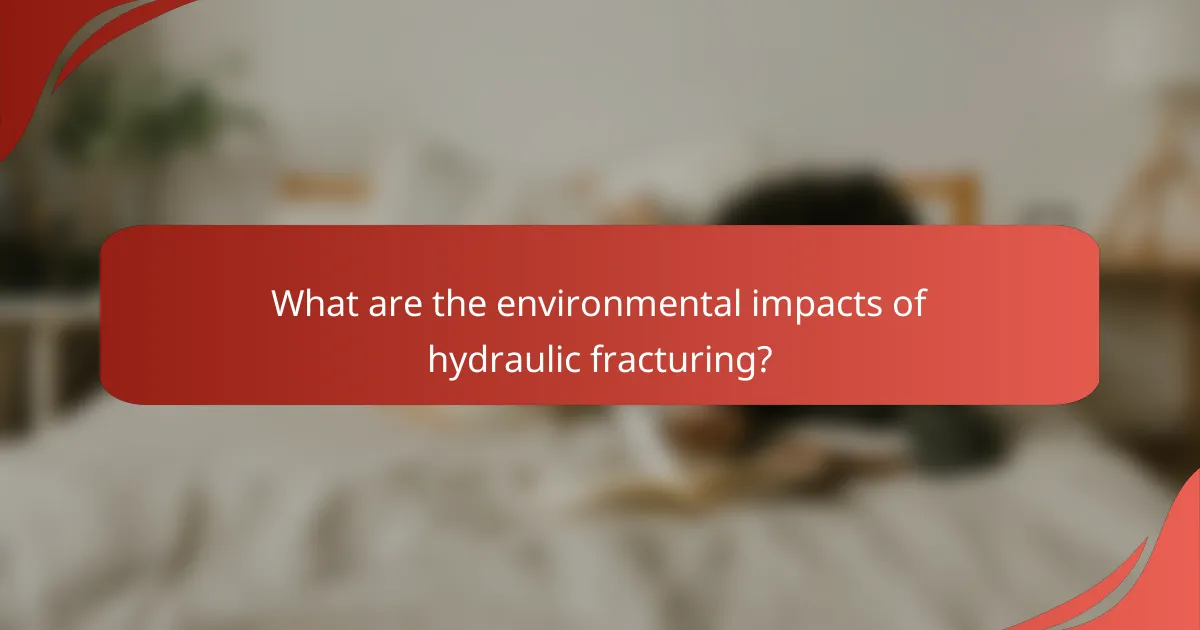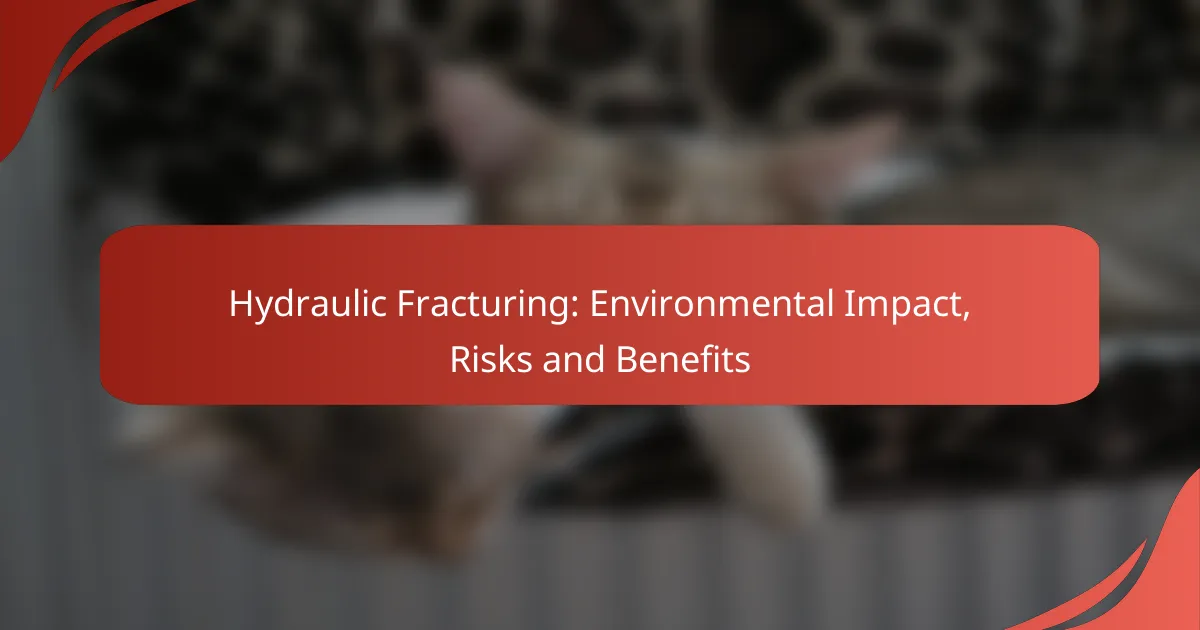Hydraulic fracturing, or fracking, is a controversial method of extracting natural gas and oil that has significant implications for the environment and public health. While it offers benefits such as increased energy production and economic growth, it also raises concerns about water contamination, air quality, and induced seismic activity. Understanding both the risks and advantages is crucial for informed discussions about its role in energy policy and environmental protection.

What are the environmental impacts of hydraulic fracturing?
Hydraulic fracturing, commonly known as fracking, can significantly affect the environment through various pathways. Key concerns include water contamination, air quality degradation, impacts on local ecosystems, greenhouse gas emissions, and changes in land use.
Water contamination risks
Water contamination is a major concern associated with hydraulic fracturing. Chemicals used in the fracking fluid can potentially seep into groundwater if not managed properly. Additionally, spills or leaks from storage pits can lead to surface water contamination, affecting drinking water sources.
To mitigate these risks, operators must adhere to strict regulations regarding the handling and disposal of wastewater. Regular monitoring of water quality in nearby wells is essential to detect any contamination early.
Air quality degradation
Hydraulic fracturing can lead to air quality degradation through the release of volatile organic compounds (VOCs) and methane during drilling and production. These emissions can contribute to smog formation and respiratory issues in nearby communities.
Implementing best practices, such as using enclosed systems for gas capture and regular maintenance of equipment, can help reduce air pollution associated with fracking activities.
Impact on local ecosystems
The development of fracking sites can disrupt local ecosystems, particularly in sensitive areas. Habitat fragmentation and the introduction of noise and light pollution can adversely affect wildlife populations and biodiversity.
To minimize ecological impacts, careful site selection and the use of directional drilling can help reduce the footprint of fracking operations on the surrounding environment.
Greenhouse gas emissions
Hydraulic fracturing can contribute to greenhouse gas emissions, primarily through methane leaks during extraction and transportation. Methane is a potent greenhouse gas, and its release can undermine the climate benefits of switching from coal to natural gas.
Monitoring and reducing methane emissions through advanced technologies and practices is crucial for minimizing the overall climate impact of fracking.
Land use changes
The expansion of hydraulic fracturing operations often leads to significant land use changes, including the construction of access roads, drilling pads, and pipelines. This can result in habitat loss and altered landscapes.
Land-use planning and restoration efforts post-drilling can help mitigate these changes, ensuring that affected areas are rehabilitated and returned to a natural state as much as possible.

What are the benefits of hydraulic fracturing?
Hydraulic fracturing, commonly known as fracking, offers several advantages, including enhanced energy production, economic growth through job creation, and lower energy costs. These benefits contribute to energy independence and technological progress in extraction methods.
Increased energy production
Hydraulic fracturing significantly boosts energy production by unlocking natural gas and oil reserves previously deemed inaccessible. This process allows for the extraction of fossil fuels from shale formations, which can lead to increased domestic supply and reduced reliance on foreign energy sources.
For instance, regions in the United States, such as Texas and Pennsylvania, have seen substantial increases in energy output due to fracking. This surge in production can help stabilize energy markets and ensure a more reliable energy supply.
Job creation in local economies
Fracking creates numerous job opportunities in local communities, particularly in areas where drilling and extraction occur. Jobs range from skilled labor in drilling operations to support roles in transportation and logistics.
According to estimates, thousands of jobs can be generated in a single fracking project, benefiting local businesses and stimulating economic growth. This influx of employment can lead to improved infrastructure and services in the surrounding areas.
Lower energy prices
One of the most immediate benefits of hydraulic fracturing is the potential for lower energy prices. Increased supply from fracking can lead to reduced costs for consumers, as the market adjusts to the higher availability of natural gas and oil.
For example, in the United States, the expansion of fracking has contributed to a significant drop in natural gas prices over the past decade, making energy more affordable for households and businesses alike. This can enhance overall economic stability and consumer spending.
Technological advancements in extraction
Hydraulic fracturing has spurred significant technological advancements in extraction techniques, making the process more efficient and environmentally friendly. Innovations such as improved drilling methods and water recycling systems have emerged as a result of the industry’s growth.
These advancements not only enhance the effectiveness of fracking but also address some environmental concerns associated with the process. For instance, advancements in monitoring and safety technologies help mitigate risks related to groundwater contamination and seismic activity.

What are the risks associated with hydraulic fracturing?
Hydraulic fracturing, or fracking, poses several risks that can impact the environment and public health. Key concerns include induced seismic activity, potential health risks to nearby communities, and challenges with regulatory compliance.
Seismic activity concerns
One of the significant risks associated with hydraulic fracturing is the potential for induced seismic activity. This occurs when the injection of high-pressure fluids into the ground alters stress levels in the Earth’s crust, which can lead to small earthquakes. While most of these tremors are minor, there have been instances where fracking activities have been linked to noticeable seismic events.
Areas with pre-existing geological vulnerabilities may be more susceptible to seismic activity. Operators often conduct geological assessments to identify such risks, but the effectiveness of these measures can vary. Monitoring seismic activity in regions where fracking occurs is crucial for mitigating this risk.
Health risks to nearby communities
Hydraulic fracturing can pose health risks to communities located near drilling sites. Concerns include exposure to air and water pollutants, which may result from the chemicals used in the fracking process. Studies have suggested that residents living close to fracking operations may experience respiratory issues, headaches, and other health problems.
To minimize health risks, it is essential for operators to adhere to strict safety protocols and for local governments to enforce regulations. Community awareness and engagement can also play a vital role in addressing potential health impacts and ensuring that residents are informed about safety measures.
Regulatory compliance issues
Regulatory compliance is a critical concern in hydraulic fracturing, as operators must navigate a complex web of local, state, and federal regulations. Non-compliance can lead to legal penalties and environmental damage. Regulations often cover aspects such as water usage, waste disposal, and chemical disclosure.
Operators should stay updated on changing regulations and ensure that their practices align with legal requirements. Engaging with regulatory agencies and participating in public consultations can help companies maintain compliance and foster community trust.

How does hydraulic fracturing compare to other extraction methods?
Hydraulic fracturing, or fracking, is often compared to conventional drilling due to its distinct techniques and impacts. While both methods extract oil and gas, fracking typically allows access to resources trapped in shale formations, which conventional drilling cannot efficiently reach.
Conventional drilling vs. hydraulic fracturing
Conventional drilling involves drilling a vertical well into a reservoir to extract oil or gas. This method is effective for easily accessible deposits but often leaves significant amounts of hydrocarbons unrecovered. In contrast, hydraulic fracturing uses high-pressure fluid to create fractures in rock formations, enhancing the flow of oil and gas to the well.
Fracking can access resources from deeper and more complex geological formations, making it a preferred choice in regions with shale deposits. However, it requires more advanced technology and carries different environmental considerations compared to traditional drilling.
Environmental impact comparison
The environmental impacts of hydraulic fracturing can differ significantly from those of conventional drilling. Fracking has been associated with concerns such as groundwater contamination, increased seismic activity, and higher water usage. In contrast, conventional drilling typically has a smaller footprint but may still pose risks to local ecosystems.
Regulations vary by region, with some areas imposing strict guidelines on fracking practices to mitigate environmental risks. Understanding local regulations is crucial for assessing the environmental impact of either method.
Cost-effectiveness analysis
Hydraulic fracturing can be more cost-effective than conventional drilling, especially in regions with rich shale deposits. The initial investment for fracking is generally higher due to the technology and infrastructure required, but the potential yield can justify the costs. In many cases, fracking can lead to a quicker return on investment due to increased production rates.
However, the long-term costs associated with environmental management and regulatory compliance can offset some of the initial financial benefits. Evaluating the total cost of ownership, including potential environmental liabilities, is essential for making informed decisions about extraction methods.

What regulations govern hydraulic fracturing?
Regulations governing hydraulic fracturing vary significantly by country and region, focusing on environmental protection, public health, and resource management. In the United States, both federal and state laws play crucial roles in overseeing the practice, while international frameworks provide additional guidelines.
Federal regulations in the United States
In the U.S., the Environmental Protection Agency (EPA) oversees several federal regulations related to hydraulic fracturing. Key laws include the Safe Drinking Water Act, which regulates underground injection practices, and the Clean Water Act, which addresses wastewater disposal and surface water protection.
Additionally, the Bureau of Land Management (BLM) sets rules for hydraulic fracturing on federal lands, requiring companies to disclose the chemicals used in the process. These regulations aim to minimize environmental risks and ensure safe operations.
State-specific regulations
States have their own regulations that can be more stringent than federal guidelines. For example, states like Texas and Pennsylvania require detailed reporting of fracturing fluids and have specific protocols for well construction and monitoring. These regulations often address local environmental concerns and resource management strategies.
Some states also implement additional measures, such as mandatory water testing before and after drilling, to safeguard local water supplies. Companies must navigate these varying regulations, which can significantly impact operational costs and project timelines.
International regulatory frameworks
Internationally, hydraulic fracturing regulations differ widely, with some countries imposing strict bans while others have adopted comprehensive regulatory frameworks. The European Union has established guidelines that emphasize environmental assessments and public consultations before permitting hydraulic fracturing activities.
Countries like Canada have developed their own sets of regulations, often incorporating both federal and provincial guidelines to address environmental and health concerns. Understanding these international frameworks is essential for companies operating in multiple jurisdictions to ensure compliance and mitigate risks.
